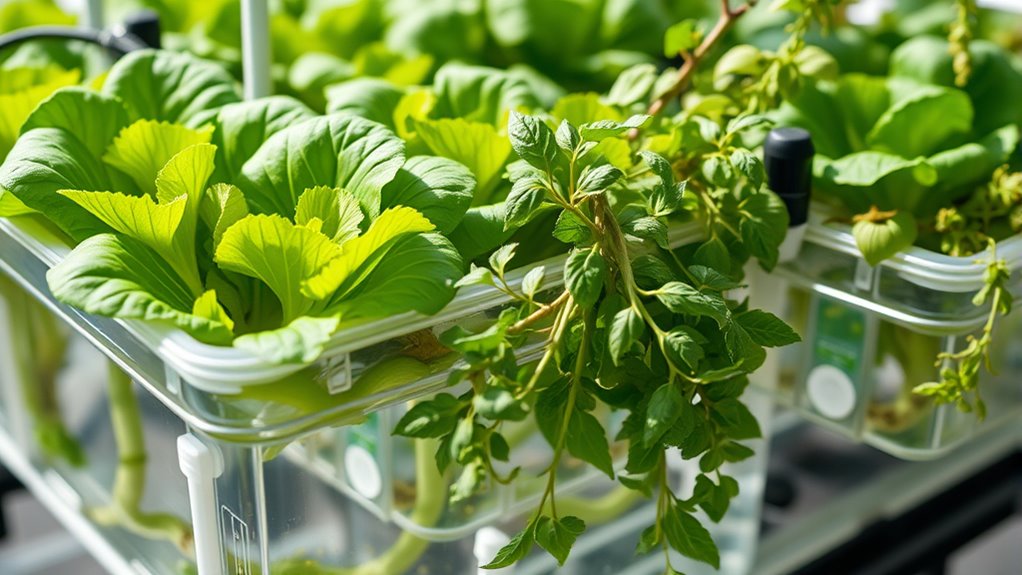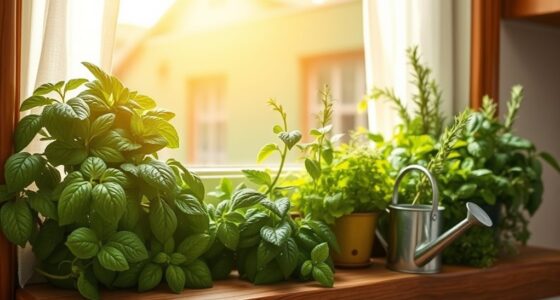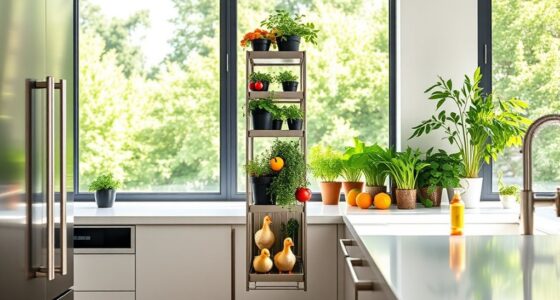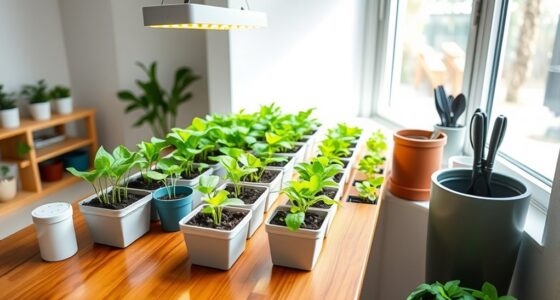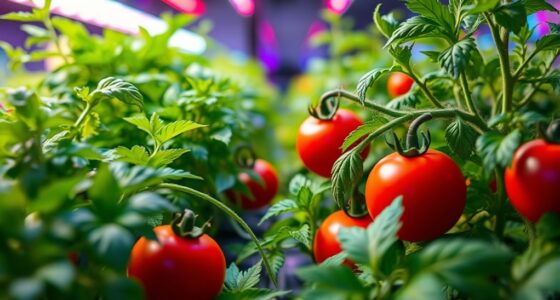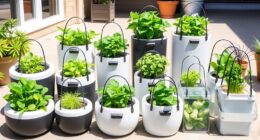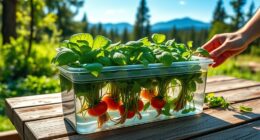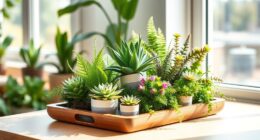Whether you need a pump depends on the type of hydroponic system you choose. Active systems rely on pumps to circulate nutrients and water consistently, making them suitable for high-yield, controlled environments. Passive systems, on the other hand, don’t require pumps and use gravity or capillary action, ideal for beginners or small gardens. To understand which setup best fits your goals and when a pump is essential, keep exploring the key differences and considerations.
Key Takeaways
- Active hydroponic systems require pumps to circulate nutrients and oxygen, ensuring consistent plant growth.
- Passive systems rely on gravity and capillary action, eliminating the need for pumps.
- Choose active systems for high-yield, controlled environments; passive systems suit small-scale or hobby gardening.
- Pumps in active systems need regular maintenance to prevent clogs and ensure proper water flow.
- The decision depends on your budget, space, desired control level, and maintenance capacity.
What Defines Active Hydroponic Systems?
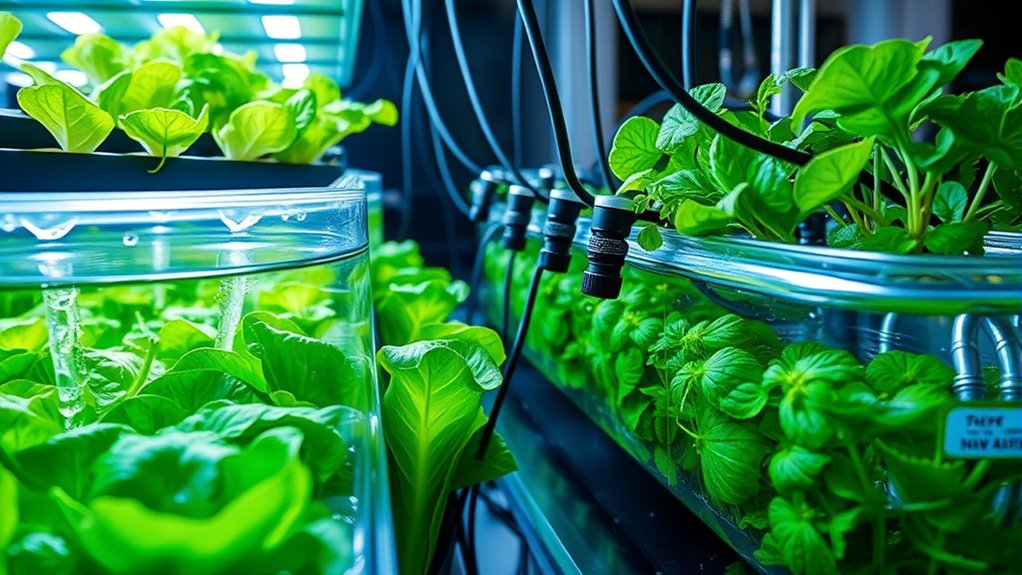
Active hydroponic systems are characterized by their reliance on mechanical means to deliver nutrients directly to plant roots. You’ll find pumps and timers that automate the nutrient delivery process, ensuring plants receive a steady supply of nutrients. This system automation reduces manual effort and helps maintain *best* growing conditions. With active setups, you control the timing and volume of nutrient flow, which can lead to faster growth and higher yields. The mechanical components work continuously or on a set schedule, preventing nutrient deficiencies or excesses. Because of this automation, active systems are often more consistent and efficient, making them ideal for commercial growers or those seeking precise control over their plants’ environment. Your plants thrive with reliable nutrient delivery, thanks to the active system’s mechanical and automated design. Additionally, understanding the importance of high contrast ratios can help optimize the visual quality of your home cinema setup, especially in dark viewing environments.
Characteristics of Passive Hydroponic Setups
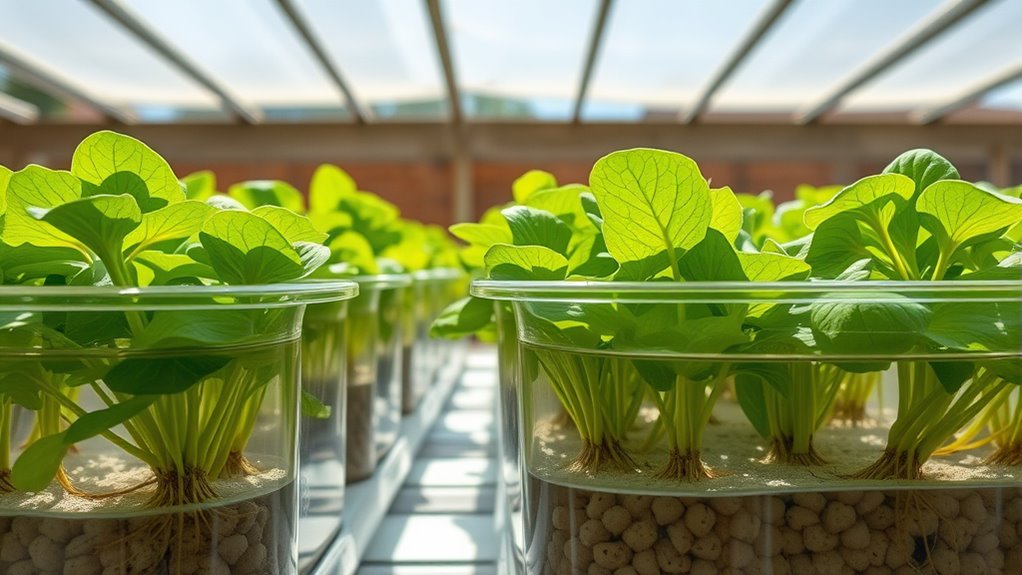
Passive hydroponic setups feature a simple design that’s easy to assemble and maintain. You won’t need complex equipment or pumps, which keeps the system straightforward. However, water movement is limited, so plants rely on natural processes for nutrient delivery. Incorporating cozy textiles like blankets and throws can create a comfortable environment for the gardener tending to the system.
Simple Design and Setup
Passive hydroponic systems are prized for their straightforward design and easy setup, making them accessible even for beginners. With no complex components, you can quickly assemble your system and start growing. The simple design ensures reliable nutrient delivery through capillary action or wicking, reducing the need for pumps or timers. Because these systems rely on gravity and natural processes, they’re highly scalable—you can expand or modify your setup without major adjustments. This flexibility allows you to adapt your system to different spaces or crop types effortlessly. Overall, passive hydroponic setups offer a practical, low-maintenance solution that simplifies the growing process while still supporting healthy plant development. It’s an excellent choice if you want an efficient, easy-to-manage hydroponic system.
Limited Water Movement
Because passive hydroponic systems rely on natural processes, water movement within them is inherently limited. Without pumps or active mechanisms, water circulation depends on gravity and capillary action, which can be slow and uneven. This limited movement affects nutrient distribution, making it harder to deliver consistent supplies of essential nutrients to plants. As a result, plants may experience nutrient buildup in some areas and deficiencies in others. You’ll need to monitor the system closely and adjust timing or placement to promote better circulation. While passive setups are simpler and energy-efficient, they may not support rapid or uniform water movement, which can impact overall plant health and growth. Understanding these limitations helps you decide if passive systems suit your gardening needs, especially considering Vetted – Flat Iron Bike features that emphasize reliability and performance.
The Role of Pumps in Active Systems
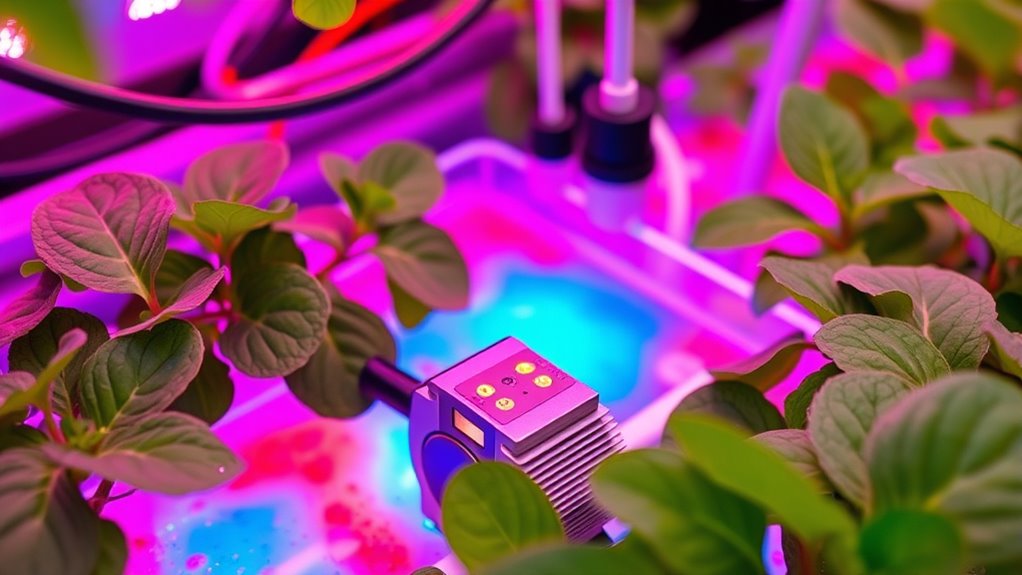
Pumps are essential in active hydroponic systems because they move nutrients and water efficiently through your setup. You can choose from various types of pumps, each suited to different scale and needs. Understanding how to maintain and troubleshoot your pump guarantees your system keeps running smoothly.
Pump Functionality Overview
In active hydroponic systems, pumps are essential components that circulate nutrient-rich water to guarantee plants receive a consistent supply of oxygen and nutrients. Their primary function is to maintain water circulation, ensuring nutrients reach the roots evenly and efficiently. A reliable pump contributes to the overall health of your system by providing steady flow without interruptions. When selecting a pump, consider its durability—you’re investing in equipment that must withstand continuous operation and resist wear over time. A durable pump reduces maintenance needs and prevents system failures that could harm your plants. Proper pump functionality ensures your active system runs smoothly, delivering the right amount of water and nutrients consistently, which is critical for ideal plant growth and productivity. Additionally, choosing a pump with high pressure capabilities can improve the overall efficiency and effectiveness of water movement within your system.
Types of Active Pumps
Active hydroponic systems utilize various types of pumps to move nutrient solutions efficiently. These pumps are essential for ensuring consistent nutrient delivery to your plants and maintaining proper drainage systems. The most common types include submersible pumps, which sit directly in the nutrient reservoir and circulate solutions continuously. External or centrifugal pumps are also popular, offering higher flow rates and durability for larger setups. Peristaltic pumps provide precise control over nutrient flow, making them ideal for systems requiring exact dosing. Choosing the right pump depends on your system’s size and complexity. Proper pump selection guarantees your plants receive a steady supply of nutrients while preventing overflows or dry spots, which is crucial for the safety of your system and plant health, optimizing growth and minimizing maintenance.
Maintenance and Troubleshooting
Regular maintenance and prompt troubleshooting are essential to keep your active hydroponic system running smoothly. Pumps can sometimes cause issues like clogs or leaks, which disrupt water flow and lead to problems like pH imbalance or nutrient deficiencies. Regularly check your pump for debris or wear, and clean or replace parts as needed. Monitor pH levels daily to prevent imbalances, and ensure nutrient solutions are properly calibrated. If plants show signs of nutrient deficiency, verify that the pump is distributing nutrients evenly. Troubleshoot water flow problems promptly to avoid root stress or disease. Staying vigilant helps prevent minor issues from escalating, guaranteeing your system remains efficient and healthy, giving your plants the optimal environment they need to thrive. Additionally, understanding the environmental impacts of your system can promote more sustainable practices such as reducing waste or energy consumption.
Advantages and Disadvantages of Active Systems

While active hydroponic systems offer precise control over nutrient delivery and water circulation, they also come with notable drawbacks. You benefit from consistent nutrient supply, which promotes healthy plant growth, and efficient water circulation that prevents stagnation. However, these systems require energy to operate pumps and timers, increasing your electricity costs and reliance on power sources. Maintenance can be more complex, as pumps and tubes need regular cleaning to prevent clogs or failures. Additionally, mechanical parts are prone to wear and require replacement over time. While active systems enable accurate environmental control, their complexity and higher operational costs can be challenging if you prefer a simpler, low-maintenance setup. Understanding system components helps in assessing the long-term viability of active hydroponics. Weighing these factors helps determine if active hydroponics suits your gardening goals.
Benefits and Limitations of Passive Hydroponics
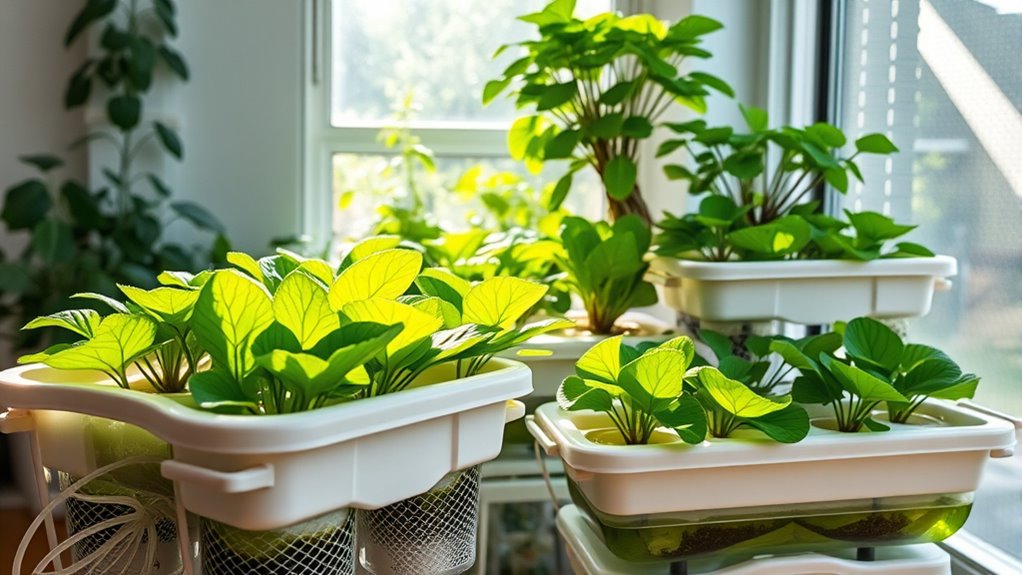
Passive hydroponic systems offer a simpler, low-maintenance alternative to active setups, making them appealing for those seeking ease of operation. They deliver nutrients through capillary action or gravity, providing a steady supply without pumps or timers. This straightforward nutrient delivery system reduces complexity and lowers costs, making passive systems accessible for beginners or small-scale growers. Additionally, passive systems are more vulnerable to issues like uneven watering or nutrient build-up, which can affect plant health. While ideal for small gardens or hobbyists, passive hydroponics may not meet the demands of commercial growers seeking rapid growth and high yields. For optimal performance, understanding the nutrient delivery process is essential to maintain healthy plant development.
Situations Where a Pump Is Essential
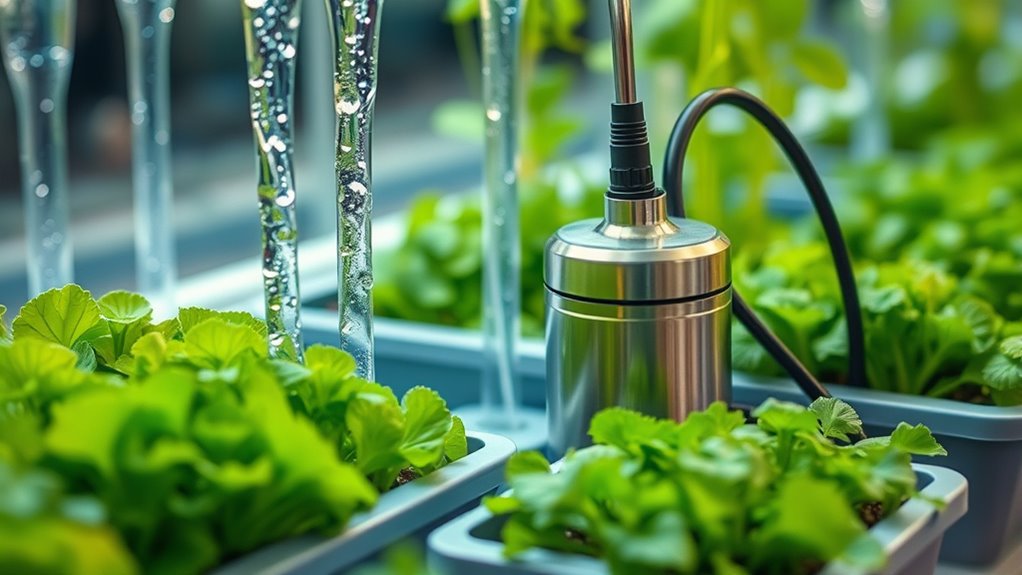
In situations where consistent nutrient delivery and precise control over environmental conditions are critical, a pump becomes essential in hydroponic systems. If you’re growing crops that require steady nutrient flow to prevent deficiencies, a pump ensures nutrients are evenly distributed. This is especially important for pest control, as it helps avoid stagnant zones where pests can thrive. Pumps also allow you to automate watering schedules, maintaining ideal moisture levels and reducing manual labor. Without a pump, nutrient delivery can become erratic, risking plant health and yield. In systems where uniformity and precision matter most, using a pump gives you the control needed to maximize growth conditions and keep pests at bay. Additionally, incorporating proper comfort solutions can improve overall system maintenance and reduce stress on the plants.
Factors Influencing Your System Choice
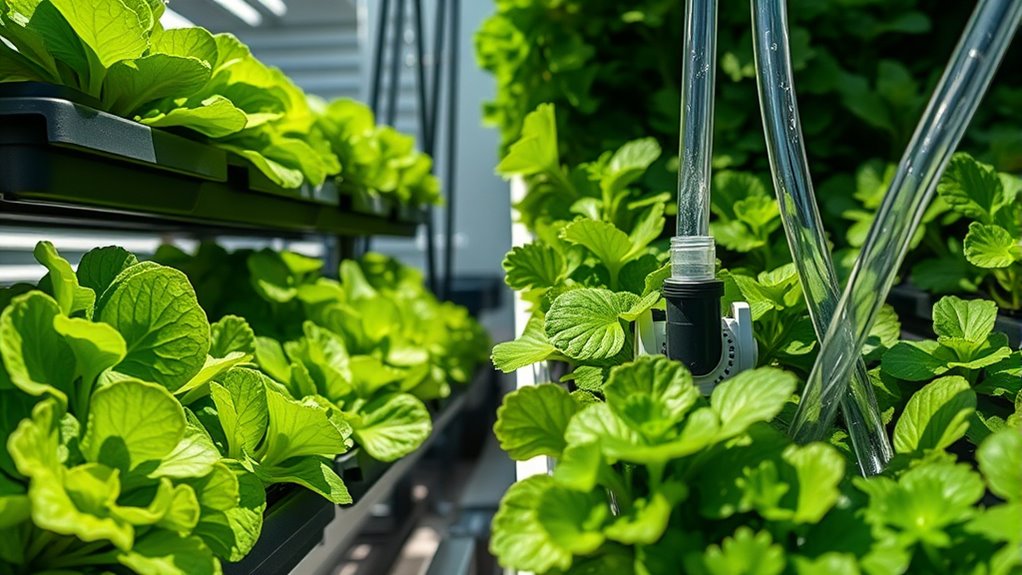
Choosing between active and passive hydroponic systems depends on several key factors, including your budget, available space, and desired level of control. Nutrient delivery is a major consideration; active systems use pumps to provide consistent, adjustable nutrient flow, ideal for larger setups or crops needing precise control. System scalability also influences your choice—passive systems are easier to expand gradually, while active systems may require more planning upfront. If you want more control over nutrient flow and plan to grow extensively, an active system might suit you better. Conversely, if you prefer a low-cost, low-maintenance setup, passive systems could be the way to go. Additionally, understanding system maintenance requirements can help you determine which system aligns best with your capabilities.
Making the Right Decision for Your Gardening Needs
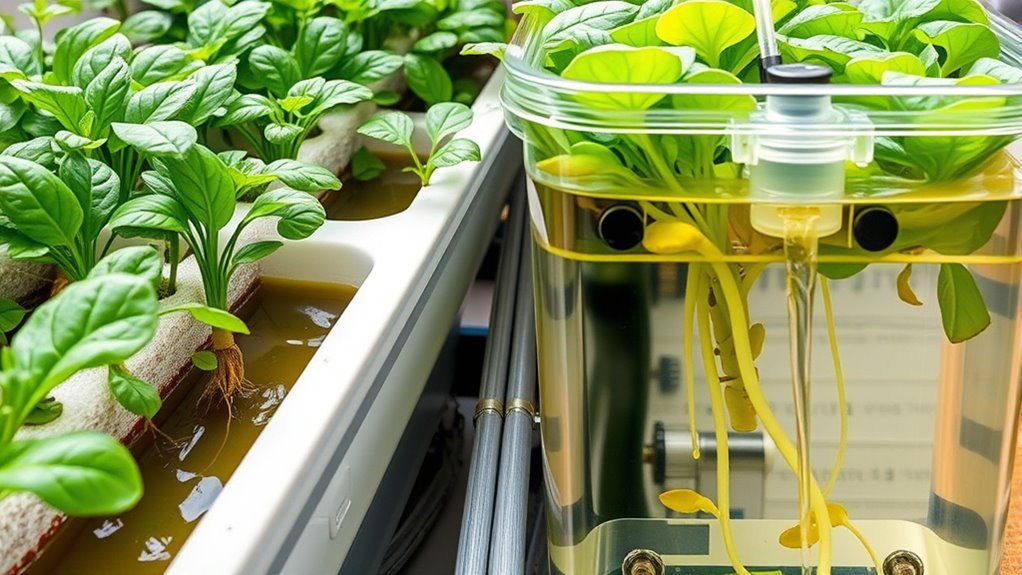
How do you determine which hydroponic system best fits your gardening goals? First, consider your nutrient balance needs—active systems often provide more consistent nutrient delivery, ideal for high-yield crops. Next, evaluate lighting requirements; passive setups typically need less intensive lighting, suitable for small or shaded spaces. To help decide, review this comparison:
| Factor | Active System | Passive System |
|---|---|---|
| Nutrient Delivery | Continuous, pump-driven | Absorption through media |
| Lighting Needs | Higher, for optimal growth | Lower, adaptable to ambient light |
| Maintenance | Moderate, pump upkeep | Low, minimal equipment |
| Space Flexibility | Larger setups, more control | Compact, easier for small areas |
| Cost | Higher initial investment | Lower startup costs |
Matching these factors with your space and goals guides your choice. Additionally, AI security technologies are increasingly used to monitor and optimize hydroponic systems, ensuring better resource management and crop health.
Frequently Asked Questions
Can Passive Systems Support Large-Scale Commercial Hydroponic Farms?
Passive hydroponic systems can support large-scale farms, but their nutrient delivery and system scalability may be restricted. You’ll find that passive setups rely on capillary action, which might struggle to meet the nutrient demands of bigger operations. While they’re simple and cost-effective, for large-scale commercial farms, active systems with pumps often ensure more consistent nutrient delivery and easier scalability, making them a more practical choice.
How Do Maintenance Requirements Differ Between Active and Passive Systems?
Imagine maintaining a thriving hydroponic jungle—passive systems demand minimal upkeep, like a gentle breeze, with simple nutrient management and rare troubleshooting. Active systems, however, are like a high-speed train, requiring constant attention to pumps, timers, and flow rates. You’ll spend more time troubleshooting issues and fine-tuning nutrient delivery, but you gain precise control. Overall, passive systems need less maintenance, while active systems demand ongoing oversight for peak performance.
Are There Hybrid Systems Combining Active and Passive Features?
Yes, there are hybrid systems that combine active and passive features, offering flexible hybrid system design. You can benefit from integrated nutrient delivery, where passive components manage water flow, while active parts control nutrient and oxygen levels. This setup allows you to optimize growth conditions and reduce maintenance, giving you greater control and efficiency. Hybrid systems are ideal if you want a customizable approach that leverages the advantages of both active and passive hydroponic methods.
What Are the Energy Consumption Differences Between the Two Systems?
When comparing active and passive hydroponic systems, you’ll notice differences in energy efficiency and power usage. Active systems typically consume more energy because they rely on pumps and motors to circulate nutrients, leading to higher power usage. Passive systems, on the other hand, use gravity and capillary action, making them more energy-efficient. Your choice depends on balancing your energy costs with your desired plant growth rate and system complexity.
How Do Initial Setup Costs Compare for Active Versus Passive Hydroponics?
When comparing costs, passive systems usually have a lower startup investment because they don’t require pumps or complex equipment. Active hydroponics, on the other hand, involves higher initial expenses due to pumps, timers, and more extensive setups. Your choice depends on your budget and goals; passive systems are more affordable upfront, but active setups might offer better control and yields, justifying their higher cost.
Conclusion
Choosing between active and passive hydroponics is like picking between a lively river and a gentle pond. If you want a fast-flowing, dynamic system, a pump is your trusty engine. But if you prefer a calm, low-maintenance approach, passive setups are your peaceful haven. Think about your gardening style and needs—whether you want the thrill of a rushing stream or the calm of still waters—and make your decision accordingly. Happy gardening!
